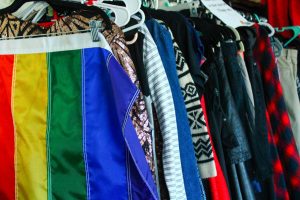Inclusive clothing bank aims to help students, faculty, staff
‘Fluid Fashion’ is open to donations, must be clean with no stains or tears
OLIVIA WOLF | THE DAILY EVERGREEN
Acacia Kapusta, former outreach and education coordinator for the Office of Outreach and Education, left, says the clothing bank offers items such as bathing suits, wigs, underwear, shoes, jewelry and hats.
August 19, 2019
A mannequin’s head with a blond wig sits on a shelf in the Gender Identity/Expression and Sexual Orientation Resource Center. Clothing racks hanging everything from plaid shirts to a bronze sequined dress are in plain sight. This is Fluid Fashion, a clothing bank started in February for anyone in need of clothes.
The clothing bank came out of two ideas: the realization that not everyone has enough clothing and a desire to be inclusive, said Acacia Kapusta, former outreach and education coordinator for the Office of Outreach and Education.
Kapusta’s last day working at WSU was Friday. Marco Cerqueira, a graduate student in cultural studies and social thought in education, will be in charge of Fluid Fashion starting today.
GIESORC Coordinator Maureen Smith said she noticed some people did not have a warm coat in the winter or proper shoes for snow.
“What this is all tied into is not just a clothing deficit,” Smith said. “This ties into a need that’s much broader. There is food insecurity. There is clothing and housing [insecurity].”
Kapusta said there was a student last winter who had a transitioning gender identity and had clothing he no longer wanted, so he brought them into GIESORC.
From there, many other people heard about the idea and donated clothes, Kapusta said.
While the clothing is donated, some of it is brand new, Smith said.
Companies donate new clothes to Fluid Fashion, Kapusta said. Most of the companies who have donated make clothes for nonbinary people, and some of the businesses are owned by LGBTQ+ people or are LGBTQ+ allies.
Nonbinary clothing is genderless and does not conform to one binary color pattern or clothing style, Kapusta said.
“We’re intentional about not separating out the styles or the sizes because we want folks to not think in that binary concept,” Kapusta said.
Kapusta said she has been working to contact adaptive clothing companies, which make clothing for disabled people. For example, it is difficult for people in wheelchairs to reach pockets when they are on the sides of pants, so adaptive clothing companies make pants with pockets on the top.

Racks of clothes hang in the Fluid Fashion community closet in the GIESORC office on Thursday at the CUB. It is open to students, faculty and staff.
Kapusta said she has also been working to include more clothing sizes into Fluid Fashion to make it more inclusive.
Many people who are in transition do not know what clothing size they are, which can be awkward in stores, Smith said.
“People are not very supportive many times. They’ll say, ‘What are you doing here? You belong over there in a different section of the store,’ ” Smith said.
Kapusta said they may also point out that someone is in the “wrong” dressing room.
Fluid Fashion allows people to try on clothes in gender-neutral bathrooms or even take them home to try on, and if something does not fit, they can bring it back, Smith said.
The clothing is for everyone, Smith said. She has seen faculty and staff using the clothing bank because some of them have limited funds.
Kapusta said, “It’s really important for us not to track … what is going out because we don’t want people to feel like they’re watched or that they are being judged. The only thing we track is the donations: what comes in.”
Fluid Fashion is open to donations, but the clothing must be clean and pressed with no stains or tears. Fluid Fashion is not a thrift store; it is a boutique, Smith said.
“Nobody wants to feel like they’re worth nothing more than cast-off,” she said. “These are beautiful clothes that can be worn proudly.”
Kapusta said they have clothing people want, including bathing suits, wigs, underwear, shoes, jewelry and hats. When people find something they really like, their faces light up.
Smith said she bought her son a Pendleton crewneck sweater but did not know that her son hates crewnecks. So, she brought the sweater to Fluid Fashion.
“I heard a kid say, ‘Oh my God, is that Pendleton? I said, ‘Yes.’ They were like, ‘Mine, mine, mine, mine.’ They put it on. And there was just excitement right there,” Smith said.
She said the clothing bank has been a success. People have already taken home hundreds of clothing items.
Smith and Kapusta have been writing a proposal for the National Association of Student Personnel Administrators, an annual conference, to show how other campuses can create their own clothing bank.
Kapusta said, “We want other folks to copy us. We want other folks to start doing what we’re doing.”




















